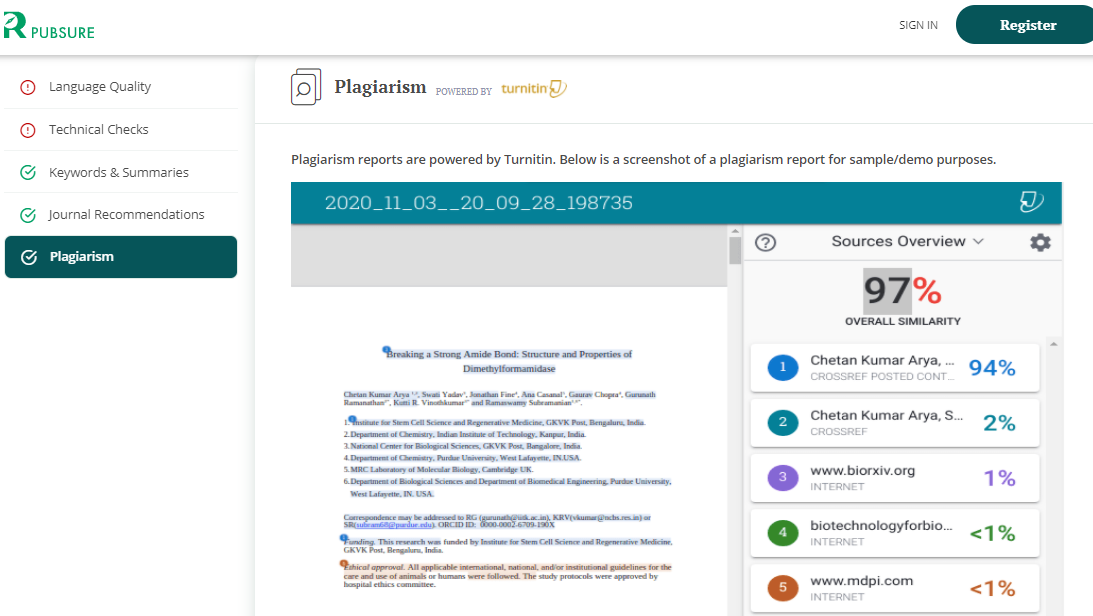Q: How do I find out the target journal's requirements for a plagiarism check?
I am using Turnitin (licensed version) to check plagiarism in my paper. I am not sure about setting the parameters, particularly the word count (whether it should be 3 or 8 as the default). How do I get information about the word count and the percentage of similarity for a particular journal? Also, what are the contents that should be included in a plagiarism check?
You have two-three questions and one overall concern: reducing / avoiding the similarity percentage (which translates to plagiarism) in your paper. Let’s take them one by one.
How do you get information about the word limit specified by the journal?
This doesn’t seem related to plagiarism, but it is critical for submission. Journals typically specify the word limit as well as what is included in that limit in their submission / author guidelines. You would need to go through these carefully. However, in case you are over by a few words or even a few hundred words (say, 100 or 200), that should be okay. (This may end up getting reduced as a result of the review and the consequent revisions.) All the same, in your cover letter, you may mention that you tried your best to reduce the word count but presently have not been able to reduce it any further. If you still feel this is critical to do for your submission, you may use an editing service for this purpose.
How do you get information about the acceptable plagiarism / similarity percentage for a journal?
Journals typically don’t mention this, but industry-wide, 15% or below is considered acceptable for an initial submission. Again, if it’s just a bit above this, you needn’t worry too much. Journal editors run a check of their own on their own tool, but use this only as an initial assessment and not to make a hard decision on the manuscript. They also look at the paper as a whole, and if it meets the grade in other areas (such as novelty, presentation, and writing), they may decide to defer the matter of the plagiarism to the revision stage. (You may learn more through this related query: I'm concerned about the similarity percentage of my plagiarism check report. Please advice.)
At times, if this is the only factor, they may send the paper back to you for reducing the plagiarism before they send the paper for peer review. Again, if needed, you may wish to employ an exclusive plagiarism service to help you resolve this.
What are the contents that should be included in a plagiarism check?
Tools, such as Turnitin, typically check text-based elements, such as the main paper (the IMRAD sections) and front matter, such as the title and abstract.
Now, in case you meant how you can reduce the plagiarism, note that a high percentage of similarity is not much of an issue in the Methods section, as the writing is mainly descriptive. In the other sections, which are more narrative, plagiarism can be an issue. So, you should work toward reducing the similarity in these sections. Again, you could do your best, but if it’s close enough (to 15%) and you really aren’t able to bring it down any further, you can let it be for now. As suggested earlier, do mention this in your cover letter so that the editor knows you did due diligence.
Incidentally, while you are using a plagiarism-focused tool for your submission, you may also wish to consider a submission-focused tool that includes a plagiarism check (in fact, powered by Turnitin). If interested, you may learn more about R Pubsure, a manuscript assessment tool that checks your manuscript along various parameters (including language, structure, declarations, and plagiarism) to ensure it is complete in every way. R Pubsure thus helps you minimize or even avoid desk rejection, which as you may well know is a crucial first goal for every manuscript. If interested, you may learn more about R Pubsure here and view a sample report here.
Hope all that helps. All the best for reducing the plagiarism and submitting your manuscript!

This content belongs to the Manuscript Writing Stage





